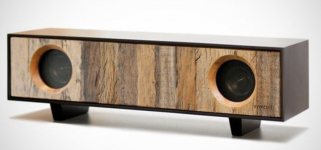Hi!
I'm planning on building a tv-stand style soundbar with high sensitivity (above ~93 db/w at least).
Height is the only dimention that is set in stone, which should be 324 mm.
Since I'm bad at crossovers, I'd like it to be as simple as possible.
As such, I'm thinking maximum 2nd order electrical.
Been looking into crossing low enough to avoid lobing, especially since the drivers will be horizontally aligned.
This means no higher than 1/2 a wavelength measured center-to-center between each driver.
Some possible driver combinations I've looked at:
DIY Sound Group Volt-10 Coax (pretty safe with finished XO, but a bit boring to go this route)
Audax 13LB25AL crossed to Faital Pro 10FE200 at 500 hz (pretty bad dispersion at higher frequencies)
Wavecor TW030WA12 crossed to Faital Pro 8FE200 at 1200 hz (don't like the XO this high tho)
Aurum Cantus AST25120 crossed to Faital Pro 10FE200 at 1000 hz (expensive, and will produce a much steeper acoustical slope, meaning I will need a higher order filter for the woofer)
To summarise, I'd like the design to be simple and safe in terms of it ending up sounding good.
Some idea of what kind of design I'm going for:
I'm planning on building a tv-stand style soundbar with high sensitivity (above ~93 db/w at least).
Height is the only dimention that is set in stone, which should be 324 mm.
Since I'm bad at crossovers, I'd like it to be as simple as possible.
As such, I'm thinking maximum 2nd order electrical.
Been looking into crossing low enough to avoid lobing, especially since the drivers will be horizontally aligned.
This means no higher than 1/2 a wavelength measured center-to-center between each driver.
Some possible driver combinations I've looked at:
DIY Sound Group Volt-10 Coax (pretty safe with finished XO, but a bit boring to go this route)
Audax 13LB25AL crossed to Faital Pro 10FE200 at 500 hz (pretty bad dispersion at higher frequencies)
Wavecor TW030WA12 crossed to Faital Pro 8FE200 at 1200 hz (don't like the XO this high tho)
Aurum Cantus AST25120 crossed to Faital Pro 10FE200 at 1000 hz (expensive, and will produce a much steeper acoustical slope, meaning I will need a higher order filter for the woofer)
To summarise, I'd like the design to be simple and safe in terms of it ending up sounding good.
Some idea of what kind of design I'm going for:
Attachments
Last edited:
-this is one area/use where active + dsp is particularly beneficial: basically get the polars you need and everything else is "gravy".
-this is one area/use where active + dsp is particularly beneficial: basically get the polars you need and everything else is "gravy".
Could you elaborate? I've tried to select drivers that should have a large flat overlap and as such be easy to design a XO for. Keeping the XO low enough should avoid lobing and beaming problems, and as such polars should be good as well. Potentially only a matter of scaling up and down the woofer no?
I'd add the Faital Pro 10HX230 (and probably the 8" version, too) to the list.
Anything in the 8-12" ProSound coaxial market would be a good starting point, although most do need some EQ to do their best work.
Chris
Anything in the 8-12" ProSound coaxial market would be a good starting point, although most do need some EQ to do their best work.
Chris
I'd add the Faital Pro 10HX230 (and probably the 8" version, too) to the list.
Anything in the 8-12" ProSound coaxial market would be a good starting point, although most do need some EQ to do their best work.
Chris
Don't think I'll be able to create a good enough crossover for a coax unfortunately. It will have to be a finished design from somewhere in that case.
Beyma has crossover for its coaxial drivers, such as the 8CX300FE. Sensitivity is a bit shy of what you're trying to achieve though.
Beyma has crossover for its coaxial drivers, such as the 8CX300FE. Sensitivity is a bit shy of what you're trying to achieve though.
Where can you find the crossovers? Unable to find anything 😕
BEYMA FD2CX a priori. But you're right it's weird, the 8CX300FE is their only coax without a crossover mentioned in the spec sheet. It might be a good idea to send them an email.
Integrate the TV so that it is effectively part of the baffle and you won't need much if any BSC. That will change the driver requirements a lot.
BEYMA FD2CX a priori. But you're right it's weird, the 8CX300FE is their only coax without a crossover mentioned in the spec sheet. It might be a good idea to send them an email.
The Radian 512/2BK looks quite nice, and has an accompanying XO

Integrate the TV so that it is effectively part of the baffle and you won't need much if any BSC. That will change the driver requirements a lot.
Unfortunately, that will take up too much space (if I understand you correctly).
I was hoping the short distance too the floor would help some with BSC.
Using the Audax widebander, I can also possibly cross low enough to get BSC for free maybe?
Could you elaborate? I've tried to select drivers that should have a large flat overlap and as such be easy to design a XO for. Keeping the XO low enough should avoid lobing and beaming problems, and as such polars should be good as well. Potentially only a matter of scaling up and down the woofer no?
..polars are problematic with this sort of design: it's not like you can rotate the loudspeakers for a given listening position, and usually a design like this is meant for more than one listener. This combo is a killer to design for - so it's made much easier with DSP (and a suitable driver combination). With respect to that:
-A (typical) wide-band driver will have directivity issues unless it has a tweeter/super-tweeter above it. Simply having a low crossover high-pass isn't going to do it for beaming (at least not at higher freq.s).
Time-delay is almost always required with a design like this (..and a relative in-ability to asethically physically alter distance, the most practical of which is horn-loading).
Time-delay is almost always required with a design like this (..and a relative in-ability to asethically physically alter distance, the most practical of which is horn-loading).
How critical is this actually? I see virtually no commercial speakers pay any respect to this (unless you can do it electrically in the XO?).
Could possibly rear mount the wideband (or tweeter) with a wide chamfer and flush mount the woofer to the baffle. That should bring them somewhat closer.
A (typical) wide-band driver will have directivity issues unless it has a tweeter/super-tweeter above it. Simply having a low crossover high-pass isn't going to do it for beaming (at least not at higher freq.s).
I'm thinking beaming in the top end is something you have to live with regardless (unless you go 3-way). Having the XO low avoids beaming of the woofer, which was what I was getting at. But of course, that can be a good thing if it's matched to the dispersion of the tweeter at XO freq.
What If I throw in a small tweeter like this?
Attachments
Last edited:
It's as "critcal" as the crossover - which means it's critical with respect to some (often minor) objective results, and potentially significant subjective results. (..like any design.) I don't think many commercial offerings even care. While this "sounds" like "waffling" on my part: for me a poor design results in limited depth reproduction.
You can get an OK polar result with a good coaxial driver.. like +/- 30 degrees stable in the crossover region up to over 10 kHz. But most are going to require DSP to achieve that good result. Also, this presumes that dispersion will do what you and your listeners need.
Ex.
The umpteenth large format coaxial driver thread
The tweeter/super-tweeter addition often adds in other issues, again easily resolved issues with DSP.
-btw, I've done this myself "on the cheap": I've got a 3 channel "sound bar" that spans about 15 feet wide and is only about 20" tall for my HT. The receiver does the equalization for a broad listening area.
You can get an OK polar result with a good coaxial driver.. like +/- 30 degrees stable in the crossover region up to over 10 kHz. But most are going to require DSP to achieve that good result. Also, this presumes that dispersion will do what you and your listeners need.
Ex.
The umpteenth large format coaxial driver thread
The tweeter/super-tweeter addition often adds in other issues, again easily resolved issues with DSP.
-btw, I've done this myself "on the cheap": I've got a 3 channel "sound bar" that spans about 15 feet wide and is only about 20" tall for my HT. The receiver does the equalization for a broad listening area.
Last edited:
Would be sweet to use that 15 inch B&C driver and just copy the XO.
Unfortunately, I don't have the space for a 15 incher as the enclosure cannot be taller than 324 mm.
Can you fix time alignment by using asymmetrical slopes?
The tweeter/super-tweeter addition often adds in other issues, again easily resolved issues with DSP.
I reckon the issues you're getting at are lobing issues? I can't see how a DSP would solve that 😕
"fix" - that's something for modeling. (..in the analog domain though it's never really "fixed", at least not overall - you are always "fighting" with freq. vs. phase/time for a given bandwidth. You could get it "fixed" at cross.. but above or below..? To what extent? ..and are you focusing more on freq. or phase?) Of course most of the time such changes are made - it's more a matter of freq. and lobe(ing) (..at least objectively).
Note: the lower you go with the wide-band tweeter - the more actual acoustic center of the mid-bass driver for those freq.s nears the baffle, this is aided with a fairly shallow profile cone (..or one with a large protruding dust cap that provides a lot of amplitude near that freq.). Often with just a bit of physical inset (+ sound absorption around the driver: 40 ppi foam) for a driver like the Aurum Cantus along with a fairly flat cone near your projected 1 kHz will get you very close (depending on what you do with the filter).
Though expensive, the Beyma Liberty 8 might be a very good match with the Aurum Cantus. 😉
Note: the lower you go with the wide-band tweeter - the more actual acoustic center of the mid-bass driver for those freq.s nears the baffle, this is aided with a fairly shallow profile cone (..or one with a large protruding dust cap that provides a lot of amplitude near that freq.). Often with just a bit of physical inset (+ sound absorption around the driver: 40 ppi foam) for a driver like the Aurum Cantus along with a fairly flat cone near your projected 1 kHz will get you very close (depending on what you do with the filter).
Though expensive, the Beyma Liberty 8 might be a very good match with the Aurum Cantus. 😉
Last edited:
Can you fix time alignment by using asymmetrical slopes?
..on a historical "note" I believe that Thiele preferred 3rd low & 5th high for an optimal combination of "slope" and phase character.
Note: the lower you go with the wide-band tweeter
(I tend to take this for granted,) but also: the lower you go in freq.the less it matters with respect to resulting freq. vs. phase rotation.
Thanks for the info and explanations, Scott!
What XO were you thinking of here?
I've played with the thought of going 2.5 way with two Seas CA22RNY.
I could offset the rising response with that second driver, netting ~94 db sensitivity.
And then cross that to something like the Morel CAT 378.
Should be able to do that with nice shallow slopes.
Though expensive, the Beyma Liberty 8 might be a very good match with the Aurum Cantus. 😉
What XO were you thinking of here?
I've played with the thought of going 2.5 way with two Seas CA22RNY.
I could offset the rising response with that second driver, netting ~94 db sensitivity.
And then cross that to something like the Morel CAT 378.
Should be able to do that with nice shallow slopes.
- Status
- Not open for further replies.
- Home
- Loudspeakers
- Multi-Way
- High sensitivity soundbar project


